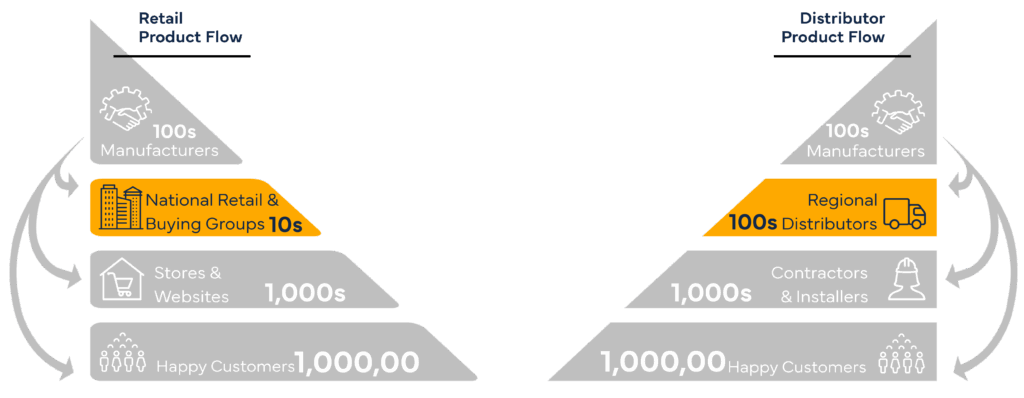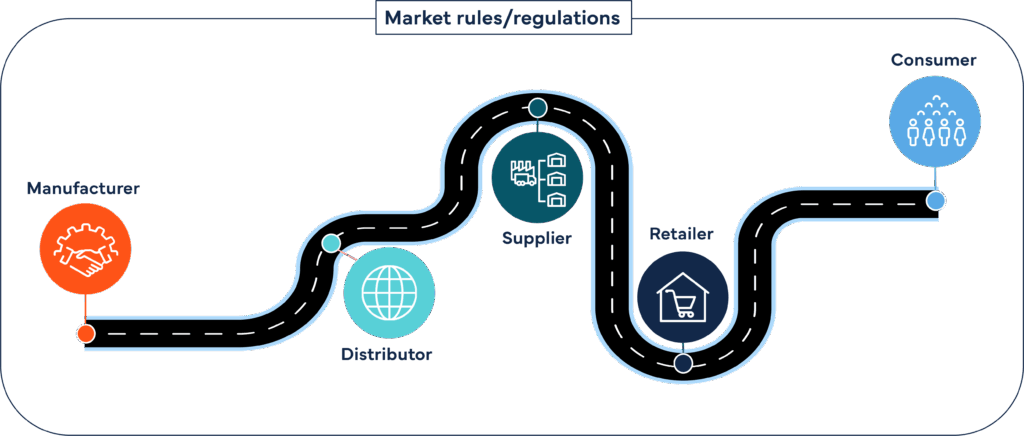Market transformation works to remove structural barriers preventing growth in market share of a technology or practice. These changes result in an accelerated adoption curve that pulls adoption forward in time and increases the maximum saturation rate. The area between these two S-curves shows the MT units that were adopted that can be attributed to MT activities, and deliver benefits such as cost-effective energy efficiency, greenhouse gas (GHG) reductions, or some other identified benefit.

Market transformation is achieved when continuing the same market intervention strategy is no longer necessary to achieve the desired outcome in that market. Efficient technologies, processes, or building design approaches are locked in through codes & standards or large market share. Market transformation succeeds by bringing the next generation of even more efficient technologies, processes, or design solutions to the market.
Interventions are typically focused on influencing supply chain entities that offer market leverage, such as manufacturers, distributors, contractors, retailers, and organizations representing industries and customer groups. This leverage can allow the intervention to have an outsized impact. The key focus for MT programs is to work with targeted market actors, and the rules that govern the products in the supply chain, to drive adoption of a technology or practice and ultimately cause it to become a normal part of how the market operates.

For example, if the market barrier is availability, an intervention strategy could incentivize manufacturers and distributors to ensure that the product inventory is available in a certain geographic area and could encourage distributors to promote the product to customers and contractors.
A market is any structure that allows buyers and sellers to exchange any type of goods, services, and information. When markets work perfectly, products are profitable, there are no barriers to entry or exit, buyers make rational purchasing decisions, labor and capital are widely available, and there’s no need for regulation.

In reality, various barriers, such as supply chain issues or price, have an impact on what’s available to buy or sell. Customers also make decisions without all relevant information and are not always rational. Common market barriers include:
Raw materials
Limited manufacturing capabilities
Limited suppliers
Paths to market
Lack of inventory
Lack of awareness
Lack of information
Availability
Price
Quality, features, performance
Market transformation works to remove key barriers that prevent the targeted technologies or practices from being adopted. It applies leverage at key points to create the changes that will allow the targeted technology or practice to become a regular or even preferred offering. Sometimes these “leverage points” include the regulations governing transactions in the market, such as safety or energy specifications for the type of equipment that is allowed to be sold.
Energy efficiency resource acquisition (RA) programs have a primary purpose of delivering cost-effective benefits to electricity and natural gas systems in the short term, typically two to four years.[1] Historically, RA programs focused on the individual consumer, although that is not a requirement of the approach.
On the other hand, market transformation focuses on working with actors upstream in the supply chain, with market-level interventions that create benefits in the longer-term, and ultimately result in large and lasting savings. Both RA and MT deliver cost-effective benefits that reduce the amount of energy needed to meet end-user demand, but on a different timeline. Finally, market transformation programs phase out once they have achieved their market goals.
The CPUC has now also has authorized “market support programs,” which can be coupled with RA to educate customers, train contractors, build partnerships, or move beneficial technologies towards greater cost-effectiveness. Education, training, and partnerships can be part of a market transformation approach but typically as support to other interventions that are changing the way a market works.
Both market transformation and traditional energy efficiency programs seek to make benefits accessible to hard-to-reach, underserved customers and disadvantaged communities, who have traditionally been left out of efficiency investments.
The following table highlights some of the classic difference between MT and RA.

Several programs in California advance emerging technologies through the research, development and demonstration stages, getting them ready for commercialization. CalMTA works to break down the barriers keeping an innovative technology from becoming mainstream. With strategic interventions and robust collaborations, market transformation initiatives (MTIs) seek to accelerate adoption of products or practices that deliver cost-effective energy efficiency and decarbonization. In many cases, MTIs seek to lock in future energy savings by working to make the technology a requirement in relevant codes and standards. CalMTA collaborates closely with emerging technology initiatives, such as CalNEXT, and codes and standards programs in California to ensure that its initiatives are supportive and aligned.
MTIs expressly seek to accelerate market adoption by effecting changes to structural aspects of the market to produce sustained market effects. [2] Like resource acquisition programs, market transformation evaluation requires accurate estimation of energy savings (and other benefits) per unit of adoption and incremental program impacts. However, evaluation of MTIs also requires estimating the change in overall market adoption induced by the market transformation effort.
CalMTA uses a three-phase stage gate model to select MTIs. The model will support an MTI from concept development through program development, market deployment, and the eventual exiting of the market. Learn more about the MTI development process in the video below.
There are several examples of successful MTIs that have been implemented across the country including lighting, resource-efficient front-loading clothes washers, Building Operator Certification, 80 Plus, etc. MTIs always begin with a logic model that describes market barriers and strategies to overcome them.
Beyond cost-effective energy efficiency, MTIs include characteristics of longevity, leverage, scale, and market readiness. Read a case study.
[1] CPUC D.21-05-031 page 14 clarifies the primarily purpose of Resource Acquisition in California for future portfolios. In the past in California and generally resource acquisition programs all over the country are geared toward meeting near-term energy-savings goals.
[2] Market effects are energy savings that result from structural market changes.

The California Market Transformation Administrator (CalMTA) develops and manages market transformation initiatives in the state to reduce energy use and reduce greenhouse gas (GHG) emissions.


CalMTA follows a rigorous process for reviewing, scoring, and then developing relevant, timely market transformation initiatives. The process supports market transformation initiative creation from concept to program development to market deployment, as well as the eventual exiting of the market.

We welcome your questions and suggestions.
Have questions or comments about CalMTA?
Use our contact form to connect with us, or reach out to:
CalMTA
Resource Innovations
719 Main Street, Suite A
Half Moon Bay, CA, 94019
(888) 217-0217
All Advisory Board meetings are open for public comment. If you’re unable to share your thoughts during an MTAB meeting, access our comment form to to provide your opinion.
Want to learn more? Sign up for our mailing list to receive twice-monthly updates about upcoming events, including Advisory Board meetings, informational webinars, important RFI deadlines, and more.